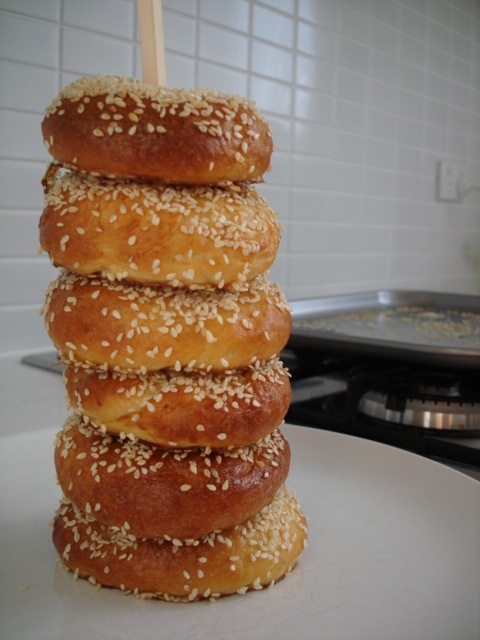Okay, apologies for the slight hiatus in
posting. With everything that’s been going on with jobs, visa paperwork, and
other time consuming things that present themselves at the busiest moment
possible, I’ve had to put writing on the back burner. But that doesn’t mean I
haven’t been hard at work cooking! I’ve got two, accidently related posts
coming up. And this is the first.
This post is about bringing back the basics;
slowing life down, and taking the time to do things yourself. And while I won’t
be hand-washing my clothes, or changing the brake pads on my car anytime soon,
I will definitely be making these bagels again. In
fact, I had such a great time with this recipe that I was inspired to start my
own sourdough culture to be done with commercial yeast forever! Exciting right?
Just getting you all on board for my next post :)
 |
| Homemade bagels AND home-cured gravlax with dilly cream cheese... stop it, I know |
But back to the bagels. Between all the recent
stressful moments, I’ve been spending as much time as possible laying in the
sunbeam that perfectly shines on my outdoor lounge. And what better activity to
do while relaxing in the sun than read a favourite author? It doesn’t matter
which book you choose, any one written by Michael Pollan is a winner. In his
newest book “Cooked” he illustrates a true back to basics lifestyle from the
origination of Carolina BBQ, to home fermented vegetables, brewing beer, and
baking bread.
In the book he makes a good point. We are
making more money, working harder, and spending way more time doing things we
don’t actually enjoy doing. And for what? Two weeks holiday? A new car? New
clothes? More stuff? More stress? I can create more than enough stress on my
own thank you very much. With only two days per week off work, is shopping
really the best thing for us? Is the only legitimate form of leisure really
consumption?
Not for me it isn’t. I get way more pleasure
out of learning how to do things for myself, and then doing it better than I
could buy anywhere else. Cooking especially. I mean how great do you feel when
you spend all day comparing recipes, prepping ingredients, and hosting a great big
dinner party for all your friends?! Super!
These bagels are my first attempt at
bagel-making. They are one of the many things I miss from home, while also
being one of the few things I can actually make (Kraft Dinner’s mysterious
powdered cheese sauce still evades me). And as my toughest critic, I would say
these bagels rate a 7/10. They looked great, and had a great chewy exterior,
the way proper bagels should. But the inner crumb was a little too crumbly, and
they were definitely too small. I’m working on improving the recipe and will
keep you posted on the results!
The great thing about these bagels, and the
reason why I’m sharing the recipe is because they were really good. They were
really easy to make, and look totally impressive. Nick and I are hosting a
friend for the next few days, and I’m definitely going to be making up a batch
of these bagels.
“You mean these ole’ things? Nah, we’ve always got them hanging around” ;)
Sesame Seed Bagels
25g butter
125 ml milk
1 tbsp caster sugar
1 tsp dried yeast
1 egg, separated
250 g bread flour
6 5x5 inch squares of parchment paper
Melt the butter, milk, and sugar in a sauce pan until the sugar is completely dissolved. Turn off the heat and let cool to body temperature. Add
the yeast and let sit until foamy, 10 min. Whisk in the egg white and ½ tsp salt.
In a big bowl sift your flour. Make a well in the centre and pour in the yeast mixture all at once. Knead until smooth and elastic.
Cover with plastic wrap and leave in a warm spot. Rise until doubled.
Divide dough into 6 pieces and roll each into a ball (using
flour as necessary). Poke your finger through the centre of each ball and spin around to make a bagel
shape. Place each shaped bagel on its own square of parchment paper. Cover and
rest until slightly risen, 30 min.
Meanwhile bring a large saucepan of water to boil and
preheat oven to 200C. Add 1 tbsp baking soda to the water (this is a substitute for lye
which is normally used when making bagels).
Slide bagels with paper attached in batches into the boiling water, turning
once until puffed. The bagels will slide easily away from the paper. Remove each boiled bagel with a slotted spoon and transfer to a nonstick baking
sheet.
Combine the remaining egg yolk with 1 tsp water and brush over
the bagels. Scatter with sesame seeds and bake approximately 20 minutes, or until golden brown.
Now the fun part... all the many ways you get to enjoy them!!
 |
| Mix up some home-cured gravlax, fresh dill, and cream cheese. Smear it on thick with some sliced cucumbers. Delicious. |
 |
| Breaky to go! |
 |
| Easy peasy toasted with peanut butter |
 |
| YUM! |













